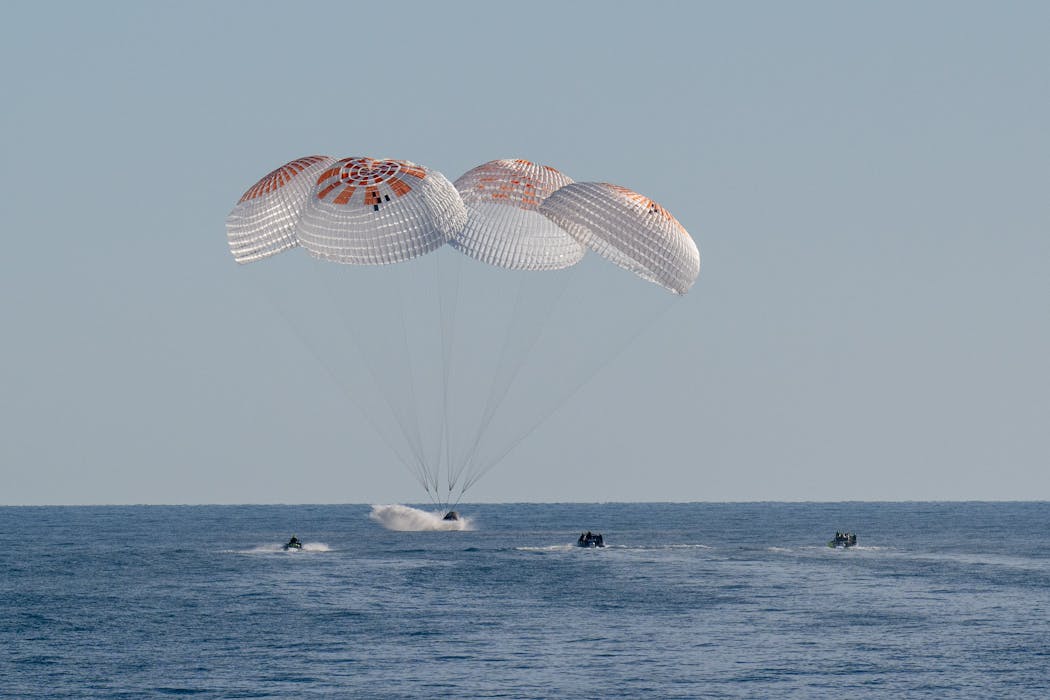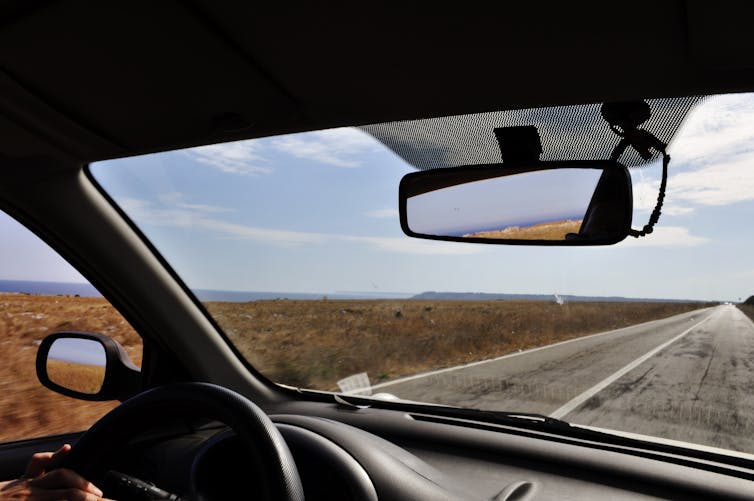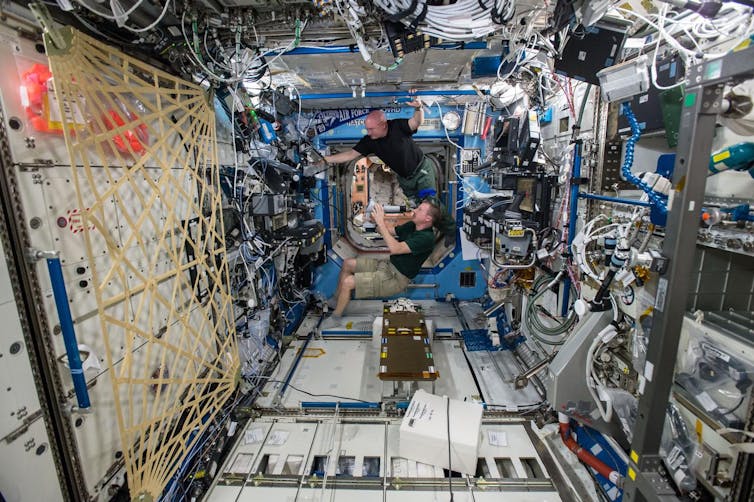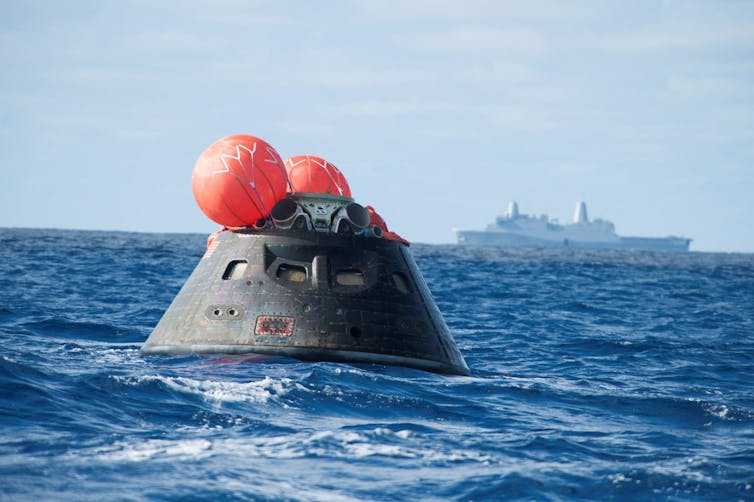Astronauts can get motion sick while splashing back down to Earth – virtual reality headsets could help them stay sharp
- Astronauts can experience motion sickness during splashdown due to conflicting sensory inputs from their vestibular system and brain, which can impair their ability to respond quickly in emergency situations.
- The conflict arises when astronauts’ brains expect gravity-based motion cues but are instead exposed to microgravity in space, leading to space motion sickness that can be exacerbated by seasickness during splashdown.
- Researchers have developed a virtual reality headset solution to mitigate motion sickness in astronauts, which shows promise for reducing debilitating symptoms by roughly half and could also benefit people prone to motion sickness on Earth.
- The system works by projecting the capsule’s motion onto a headset, providing a visual cue that aligns with the astronaut’s expected movement, thereby reducing sensory conflict and alleviating nausea.
- Future research aims to improve this technology further, potentially incorporating predictive modeling of capsule motion to provide even more effective relief for astronauts during splashdown and other high-risk situations.

When learning about the effects of spaceflight on human health, you typically will hear about the dangers of radiation, bone density loss and changes in eyesight. While these long-term risks are important, a less frequently discussed concern is motion sickness.
As a child, one of us (Taylor) was highly prone to motion sickness – whether in the backseat of a car, sitting on a train or riding a bus. At the time, she considered it a cruel twist of fate, but as an adult – and a scientist to boot – Taylor can tell you with confidence that it was entirely her fault.
You see, like most children during long car rides, Taylor would get bored. So, to combat this boredom, she would either read a book or play on her Gameboy. She would stare down at whatever form of entertainment was in her lap that day until the familiar creeping sensation of nausea developed.
Sometimes, looking out the side window would help, but more often than not, Taylor’s dad would have to pull over at the next gas station for a short break, or else they’d all suffer the consequences.
Now, she understands what was happening on a more fundamental level. As children, you are taught about the five senses: sight, hearing, smell, taste and touch. However, there is a hidden sixth sense that helps your body understand how you are moving – the vestibular system. The brain takes information from all these senses and compares it to what it might expect when moving, based on past experiences.
Optimally, any disagreement between your vestibular senses and your brain’s expectations would be small. But when there are large, sustained conflicts, you get sick.
While reading in the car, Taylor was staring at nonmoving words on a page while her vestibular system told her brain she was traveling down a road. This discrepancy confused her brain since usually, when Taylor felt movement, she should see the world shifting around her in the same way – hence her motion sickness. Had she been looking out the window and watching the world pass by, she would have been fine. Even better, had she been in the front seat, she would have been able to see the road ahead and predict how she would move in the future.

EyeEm Mobile GmbH/iStock via Getty Images
The sensory conflict between what you experience and what your brain expects doesn’t cause only carsickness. It is also the leading suspect behind cybersickness from using virtual reality headsets, seasickness on ships and spaceflight-driven motion sickness. Our team of aerospace engineers is particularly interested in the latter.
Motion sickness during spaceflight
To date, all astronauts have grown up on Earth. So, their brains expect any motion cues to include the presence of Earth’s gravity. But when they get to orbit in space, that is no longer the case.
When in orbit around Earth in microgravity, the vestibular system does not have any gravitational input. The conflict between the brain’s expectation of Earth’s gravity and the reality of no gravity causes space motion sickness.

Johnson Space Center
Thankfully, the brain’s expectations can change over time, after enough exposure to a new environment. Often referred to as “getting your sea legs” in the nautical community, astronauts also eventually overcome space motion sickness while in space. However, overcoming it introduces another problem when they return.
If an astronaut’s brain expects microgravity, what happens when they come back to Earth? As you might expect, the process starts again, and astronauts are now prone to terrestrial readaptation motion sickness. To make matters worse, since the retirement of the space shuttle, crew vehicles frequently land in the water, which means astronauts may deal with choppy waves until their capsule is recovered. Seasickness can potentially exacerbate terrestrial readaptation motion sickness.

Anthony W. Gray/Kennedy Space Center
These conditions are not rare. Over half of all astronauts experience some symptoms of space motion sickness when they first get to space, and terrestrial readaptation motion sickness occurs at a similar incidence rate when they come back down.
Dangers to astronauts
If you have ever experienced motion sickness, you know how hard it is to do anything other than close your eyes and take deep breaths to expel the creeping urge to vomit. As a passenger in a car, that may be OK, since you aren’t expected to jump into action at a moment’s notice. But while isolated on the water in a return capsule, astronauts need to remain focused and clearheaded. In case of an emergency, they’ll need to respond rapidly.
If the astronauts need to get out of the capsule prior to pickup up by the recovery team, any motion sickness they have could delay their response time and impede evacuation attempts.
Potential solutions
Presently, most astronauts rely on medication that interrupts the brain’s ability to use hormones to trigger motion sickness. However, as with many commercial products, these drugs can cause side effects such as drowsiness and can lose efficacy over time.
Our research team completed two experiments to investigate how we might be able to manipulate visual information to mitigate motion sickness in astronauts, without relying on pharmaceuticals.
Our participants were exposed to motions meant to simulate transitions between gravity environments and then ocean wavelike motion. During the hour of wavelike motion, we investigated whether a “virtual window” could reduce the incidence of motion sickness.
When in a capsule on the ocean, astronauts are strapped into their seats and likely cannot see out of the small windows built into the capsule. In place of windows, we used virtual reality headsets to create a full-view virtual window.
In our control group, the subjects received no visual cues of motion – akin to Taylor’s poorly advised backseat reading. Meanwhile, one countermeasure group got to see a visual scene that moved naturally with their motion, like looking out the side window of the car at the surrounding world. The other countermeasure group saw a scene that moved appropriately and was provided an overlay showing future motion, like looking out the front window and seeing the road ahead.
As expected, the group with no cues of motion got the sickest. Two-thirds of the subjects needed to stop prior to finishing an hour of wavelike motion, due to excessive nausea. Only about one-fifth of the group that was given the side window view needed to stop early. Only one-tenth of the front window group that received present and future visual cues dropped out.
These results mean that by tracking the capsule motion and projecting it on a headset for the astronauts inside, our team may be able to reduce debilitating motion sickness by roughly half. If we could figure out how to predict how the capsule would move, we could give them that front window experience and improve the landing even more. In case of emergency, they could always take off the headsets.
This work shows promise for motion sickness interventions that do not rely on pharmaceuticals, which are currently used to combat these effects. Our solutions don’t have the same concerns around shelf life, stability or side effects. In addition to the benefits for astronauts, such approaches could help those prone to motion sickness here on Earth, particularly in scenarios where looking out the front window at the road isn’t feasible, such as on planes, trains, buses or high-speed transportation.
![]()
This work was supported by the National Aeronautics and Space Administration Human Research Program under Grant No. 80NSSC21K0257.
Torin Clark receives funding from NASA, the Office of Naval Research and the National Institutes for Health, and he receives fellowships from the Charles Stark Draper Laboratory and the National Science Foundation.
